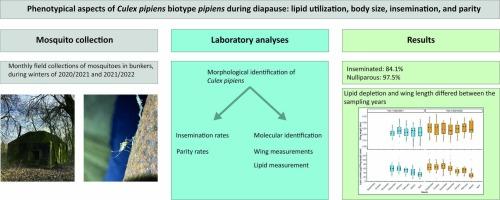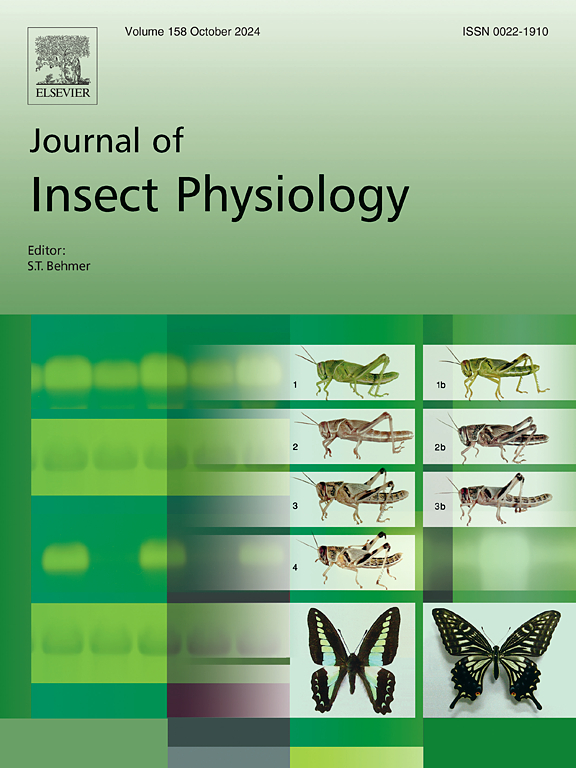琵鹭库蚊生物型在休眠期的表型:脂质利用、体型、受精和奇偶性
IF 2.3
2区 农林科学
Q1 ENTOMOLOGY
引用次数: 0
摘要
在温带地区,雌性库蚊生物型琵琶蚊在冬季会休眠。处于休眠状态的生物型琵琶蚊可能是蚊媒病毒(如西尼罗河病毒、乌苏图病毒和辛比斯病毒)的重要冬季贮藏地。进入冬季前,处于休眠状态的蚊子没有吸血。因此,它们不会通过吸食有传染性的血液而受到感染,因此,垂直传播被认为是蚊媒病毒越冬的主要机制。在越冬前,生物型琵琶蚊会积累脂肪储备,并在整个冬季使用。此外,早期的研究表明,体型越大,越冬存活率越高。然而,人们对处于休眠期的野生琵琶蚊的脂质利用和体型知之甚少。因此,我们在连续两个冬季(2020/2021年和2021/2022年)每月在荷兰新荷兰水线的沙坑中收集处于休眠状态的生物型琵琶蚊。每个月,我们都会通过显微镜检查受精雌蚊和副雌蚊的比例。此外,我们还测量翼长(代表体型),并评估总脂质含量。此外,我们还监测了越冬地点的室内温度。我们的研究表明,越冬地点的环境相对稳定,温度很少低于 0 °C。绝大多数生物型琵鹭雌性都是人工授精(84.1%)和无产卵(97.5%)。我们发现,在采样的两个年份之间,雌性琵鹭的体型存在差异,但在采样的两个年份之内,雌性琵鹭的体型没有差异。此外,我们还检测到不同采样年份之间脂肪含量的差异。我们证实,绝大多数腹泻琵琶鱼雌性都是人工授精且无产卵。这表明它们在越冬前没有吸血,这突出表明垂直传播可能是病毒越冬的主要机制。不同年份蚊子体型的差异很可能是由于蚊子幼虫时期所处的夏季环境不同造成的,不过这一点还需要确认。脂质消耗的差异不能用气候条件的差异来解释。为了进一步阐明气候条件、体型、脂质损耗之间的联系,以及对蚊子种群动态和虫媒病毒传播的影响,需要在未来开展实验工作,例如先暴露于虫媒病毒,然后再人工诱导休眠。本文章由计算机程序翻译,如有差异,请以英文原文为准。

Phenotypical aspects of Culex pipiens biotype pipiens during diapause: Lipid utilization, body size, insemination, and parity
In temperate regions, female Culex pipiens biotype pipiens mosquitoes undergo diapause in winter. Diapausing biotype pipiens mosquitoes are potentially important winter reservoirs for mosquito-borne viruses, such as West Nile virus (WNV), Usutu virus (USUV), and Sindbis virus (SINV). Mosquitoes in diapause have not taken a bloodmeal prior to winter. Therefore, they do not become infected by taking an infectious bloodmeal and as a consequence, vertical transmission is considered the primary mechanism of mosquito-borne virus overwintering. Prior to winter, biotype pipiens mosquitoes build up fat reserves, which they utilize throughout winter. Furthermore, earlier studies have indicated that larger body size is correlated with increased survival during winter. However, not much is known about lipid utilization and body size of wild biotype pipiens mosquitoes in diapause. Therefore, we performed monthly collections of diapausing biotype pipiens mosquitoes in two consecutive winters (2020/2021 and 2021/2022) in bunkers of the New Hollandic Waterline in the Netherlands. Every month, we checked the proportion of inseminated and parous females via microscopy. In addition, we measured wing length as proxy for body size, and assessed total lipid content. Furthermore, we monitored indoor temperature in the overwintering locations. We show that the overwintering sites in our study provide relatively stable environments, in which temperatures rarely drop below 0 °C. The vast majority of biotype pipiens females were inseminated (84.1 %) and nulliparous (97.5 %). We detected differences in body size between but not within the two years of sampling. Additionally, we detected a difference in lipid content between the sampling years. We confirm that the vast majority of diapausing biotype pipiens females are inseminated and nulliparous. This indicates that they did not blood feed prior to winter, which underscores the likeliness of vertical transmission being the primary mechanism behind virus overwintering. The detected difference in body size between years can most likely be attributed to differences in summer conditions the mosquitoes were exposed to as larvae, although this needs confirmation. The difference in lipid depletion could not be explained by differences in climatic conditions. To shed more light on the links between climatic conditions, body size, lipid depletion and the consequences for mosquito population dynamics and arbovirus transmission, future experimental work, for example by arbovirus exposure followed by artificially induced diapause, is desired.
求助全文
通过发布文献求助,成功后即可免费获取论文全文。
去求助
来源期刊

Journal of insect physiology
生物-昆虫学
CiteScore
4.50
自引率
4.50%
发文量
77
审稿时长
57 days
期刊介绍:
All aspects of insect physiology are published in this journal which will also accept papers on the physiology of other arthropods, if the referees consider the work to be of general interest. The coverage includes endocrinology (in relation to moulting, reproduction and metabolism), pheromones, neurobiology (cellular, integrative and developmental), physiological pharmacology, nutrition (food selection, digestion and absorption), homeostasis, excretion, reproduction and behaviour. Papers covering functional genomics and molecular approaches to physiological problems will also be included. Communications on structure and applied entomology can be published if the subject matter has an explicit bearing on the physiology of arthropods. Review articles and novel method papers are also welcomed.
 求助内容:
求助内容: 应助结果提醒方式:
应助结果提醒方式:


